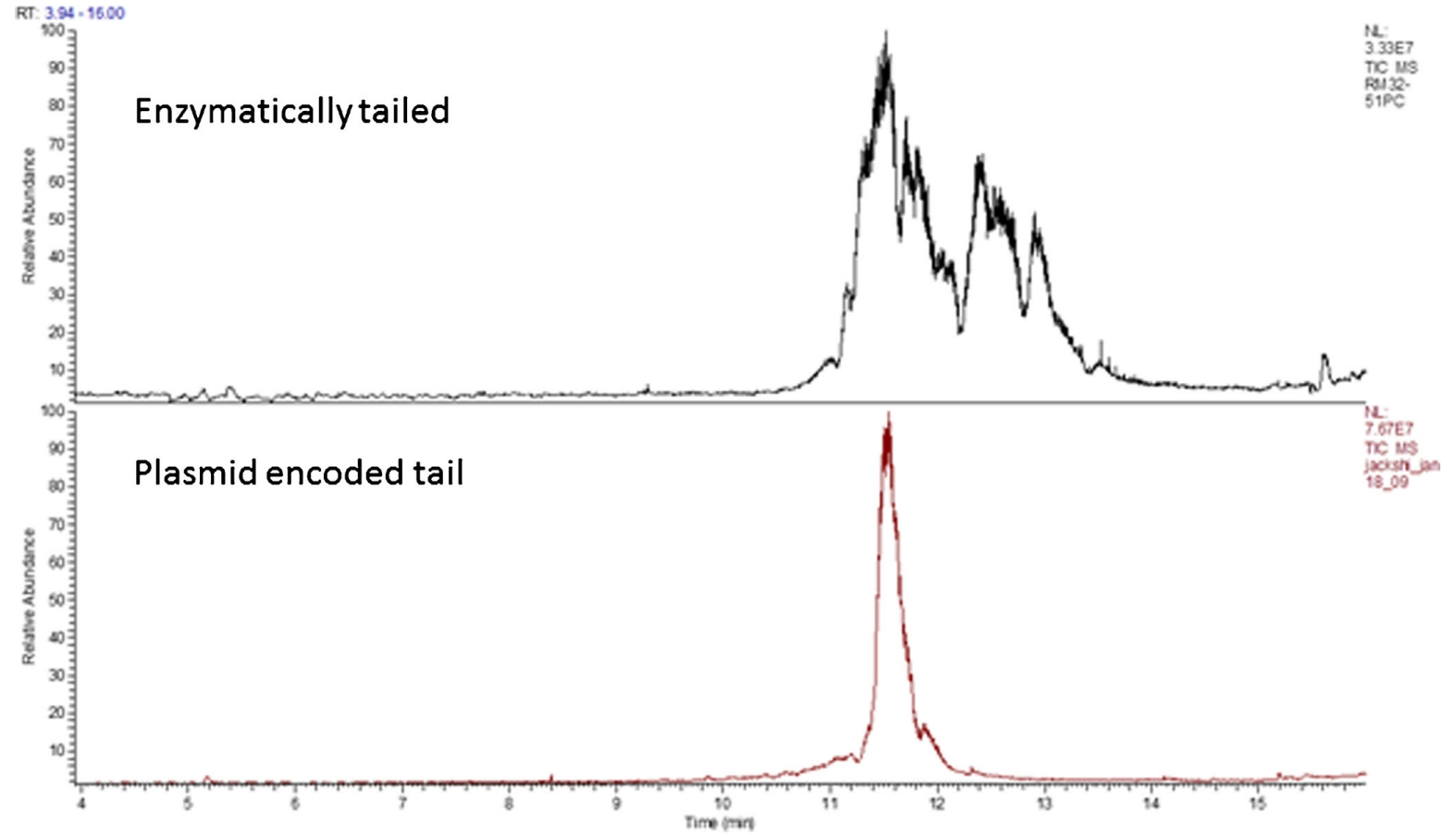mRNA 3' poly (A) Tail Analysis Service
- RNase T1 cleaves RNA exclusively at guanine (rG) residues, and since the poly (A) tail contains no rG, the full poly (A) sequence remains intact while other RNA fragments are removed. This enhances both specificity and sensitivity.
- This method can resolve poly (A) tails up to 150 nucleotides in length, allowing high-resolution detection across a wide range of tail sizes.
- We perform qualitative and quantitative analyses of poly (A) fragments using LC-MS, enabling precise measurement of tail-length distributions.
- With high-resolution Orbitrap MS, we can identify modification states—such as 2'-O-methylation and pseudouridine—supporting mRNA stability and improving translational efficiency.
- By integrating sequence information provided by the client, we can calculate theoretical target masses for the poly (A) tail, achieving more accurate structural elucidation.
mRNA 3' poly (A) tail analysis is a critical approach for characterizing the polyadenylate (poly (A)) tail at the 3' end of mRNA. Its primary objective is to evaluate mRNA stability, translational efficiency, and degradation patterns. As a vital structural element—commonly comprising 50–250 adenosine residues—the Poly (A) tail profoundly impacts mRNA half-life within the cell, influences nuclear export, and affects overall protein production levels.
In areas such as mRNA vaccines, gene editing, protein replacement therapies, and cell therapy, refining the poly (A) tail has emerged as a key strategy to enhance the potency of mRNA-based therapeutics. Nonetheless, fluctuations in tail length, premature truncation, or degradation can diminish translational efficiency and compromise stability. Accurately quantifying Poly (A) tail length and structure, as well as mapping its interactions with translational regulators, is therefore essential for optimizing mRNA design and maintaining consistent drug quality.

Figure 1. Schematic representation of mRNA structure
Leveraging high-resolution liquid chromatography–mass spectrometry (LC-MS) in combination with an RNase T1 digestion protocol, MtoZ Biolabs offers a high-sensitivity mRNA 3' Poly (A) Tail Analysis Service. Our mRNA 3' Poly (A) Tail Analysis Service precisely measures poly (A) tail length, identifies modification patterns, and assesses degradation properties—providing robust data to support both RNA biology research and mRNA drug development.
Services at MtoZ Biolabs
Because full-length mRNA is large and highly heterogeneous, direct LC-MS analysis is impractical. Instead, an enzymatic digestion approach is used to release the poly (A) tail from the mRNA, enabling high-sensitivity detection. At MtoZ Biolabs, we employ an RNase T1 digestion workflow coupled with LC-MS, ensuring precise enrichment and efficient analysis of the poly (A) tail.
1. RNase T1 Digestion Strategy
2. High-Accuracy LC-MS Analysis
3. Accurate Data Interpretation

Beverly, M. et al. ANAL BIOANAL CHEM. 2018.
Figure 2. Total Ion Chromatograms of mRNA 3' poly (A) Tail Analysis by LC-MS
Service Advantages
Drawing on deep expertise in chromatography and mass spectrometry, MtoZ Biolabs has developed a mature and systematic workflow , offering high-quality, professional mRNA 3' Poly (A) Tail Analysis Service to both research institutions and industry partners. Key advantages include:
· High Resolution and Precision: By combining high-throughput sequencing with LC-MS/MS, we can detect poly (A) tail lengths at single-nucleotide resolution.
· Broad Sample Compatibility: Our methods accommodate cell lines, tissues, blood samples, and clinical specimens for wide-ranging applications.
· Integrated Quantitative and Qualitative Analysis: We not only determine poly (A) tail length but also assess dynamic changes and modification patterns.
· Automated Data Processing: With robust bioinformatics tools, we ensure accuracy and reproducibility in data analysis.
· One-Time-Charge: Our pricing is transparent, no hidden fees or additional costs.
Applications
MtoZ Biolabs’ mRNA 3' poly (A) Tail Analysis Service supports multiple cutting-edge research areas by providing reliable data:
· mRNA Stability Investigations: Track how poly (A) tail length fluctuates under various environmental conditions or stimuli, revealing underlying mRNA degradation pathways.
· Gene Expression Regulation: Clarify the role of the poly (A) tail in post-transcriptional control and facilitate studies on translational efficiency.
· Development and Differentiation Research: Explore how poly (A) tails influence cell development, differentiation, and stem cell fate.
· Neuroscience Research: Examine the impact of mRNA 3' poly (A) tails on synaptic plasticity and neurodegenerative diseases.
· Cancer and Disease Biomarkers: Identify distinctive poly (A) tail alterations in cancer cells to support tumor biomarker discovery.
FAQ
Q1: Why is mRNA 3' poly (A) tail length so important for gene expression research?
The length of the mRNA 3' poly (A) tail directly affects mRNA stability, transport efficiency, and translational capacity. Shorter tails often lead to faster mRNA degradation, whereas longer tails typically correlate with enhanced translation. Because poly (A) tail length can vary across cell types, developmental stages, and disease states, our mRNA 3' poly (A) Tail Analysis Service can elucidate how these variations regulate gene expression networks.
Q2: Can this service detect modifications on the poly (A) tail?
Absolutely. In addition to precisely measuring poly (A) tail length, our mRNA 3' poly (A) Tail Analysis Service when integrated with LC-MS/MS or Nanopore sequencing, can reveal modification patterns such as m6A methylation or A-to-I editing. These modifications significantly influence mRNA stability and translational efficiency, making them vital for understanding gene regulatory mechanisms.
Deliverables
1. Comprehensive Experimental Details
2. Materials, Instruments, and Methods
3. Total Ion Chromatogram & Quality Control Assessment
4. Data Analysis, Preprocessing, and Estimation
5. Bioinformatics Analysis
6. Raw Data Files
We welcome your inquiries for more details about our mRNA 3' poly (A) Tail Analysis Service!
How to order?







